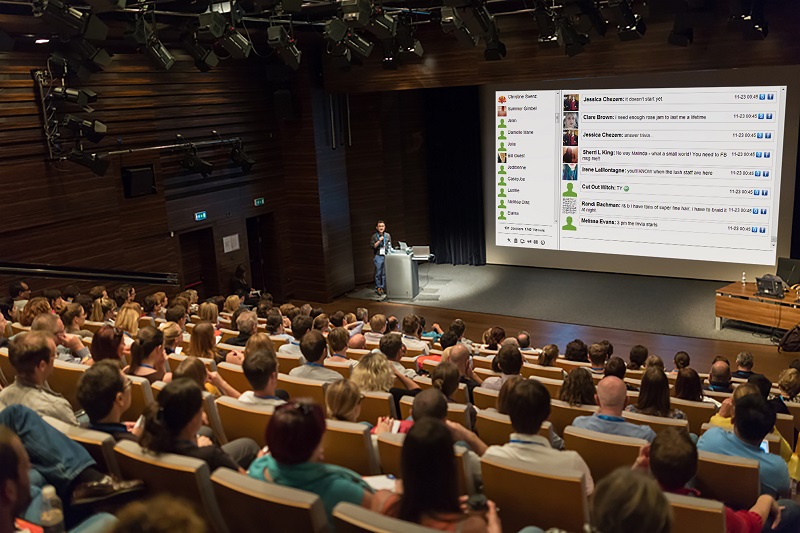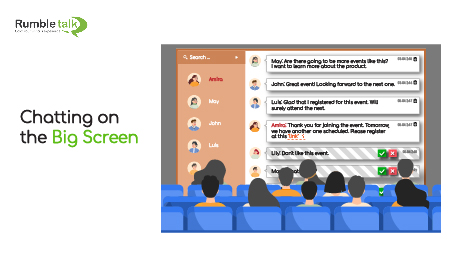Looking beyond the big screen for a moment, we’re all familiar with the common and often ubiquitous ways that chat and messaging services are used today. From technical support from our ISP and sales pitches from car dealers to booking assistance from travel agents, more and more businesses and industries are making use of this service daily.
So let’s innovate.
Screen, Screen, Screen
South by Southwest is a ten-day conference/music festival/game expo that lets professionals and consumers see what’s coming soon in entertainment, technology, and more. Over seventy thousand people attend its keynote speeches and panels each year.
The Consumer Electronics Show focuses on the edges of science and technology. With keynote speakers covering topics from healthcare technology to protecting privacy, over one hundred and twenty thousand people attended the conference in 2017. It generated over one hundred million online interactions.
Concerts, music festivals, TED conferences, and political rallies all draw thousands of people to one place, some for days at a time. They demonstrate or discuss, educate or entertain. But what do they all have in common?
They all have a big screen! Truly massive, larger-than-you-may-realize screens help the crowd see who’s speaking or performing. Often times they serve other functions too. Some events attempt to make use of social media as a way to communicate with the crowd and display the messages. But it’s not always effective.
Failures to Communicate
For example, many social media platforms have their own methods of interacting directly with accounts or events. This can cause confusion to those present. There are also delays due to various technical reasons that can prevent time-sensitive questions or messages from reaching the screen in time.
Many conferences now provide various methods of virtual attendance. It allows a person or persons to view the information live from wherever is convenient. Again, media platforms are utilized at times to try and let those virtual attendees participate in events as though physically present. But, again, the method can fall short.
These platforms are open and widely-used. But if they’re ineffective, what’s an alternative? Instead of something broad, think of an enclosed, contained system specific to that event, speaker, or performer. It would need to be a specific type of system, though, to meet the most needs and offer the best options. What do we mean?
Establishing an Uplink
The ideal solution would counter the problems we’ve identified. It would need to be closed so that it could be quick, simple to prevent confusion, and virtual so that it could be accessed remotely. Simple enough on the surface. A few ideas likely spring to mind right away.
- Nearly every venue has a local network, often wireless. Utilizing it could allow for a closed, responsive system. It would prevent easy remote access, though.
- Likewise, there are web-based teleconference services that exist. Those usually cost quite a bit of money, suffer lags, and also prevent easy access to local users.
- An app seems the most obvious solution. But some people are reluctant to download yet another app, and may have storage space to consider if they want to take pictures. Carrier and equipment varieties may impact performance, as well.

Traditional solutions won’t work. Quick solutions won’t work. This is a major opportunity event organizers don’t want to overlook. What other options are there?
How RumbleTalk Helps—Chatting on the Big Screen
The Internet. At the very base of all these solutions is the same vital component that makes them function. For over three decades, we’ve accessed that component in one particular way above all others. For most of us, the earliest we remember is Netscape Navigator. Now the vast majority use Chrome.
A browser-based solution would provide excellent versatility. It’s open because it lives on the Internet, so it can be accessed anywhere. It responds via direct access, which limits lag time significantly. Browsers are included on phones, so there’s no extra download. But can a browser work on a big screen, computer, and phone?
RumbleTalk can. Because RumbleTalk is built using HTML5, you can resize it to fit any screen with no loss of quality. That means it looks just as good on that giant screen as it does on your computer or phone, or even your own television.
Chat is becoming ubiquitous as a service, but there are many paths of innovation left. Mass communication at crowded events is just one potential avenue we’re looking forward to walking.

